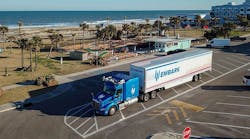With Uber testing self-driving cars for delivery, it's no surprise that a new, self-driving truck is making its way into headlines.
The modified Peterbilt tractor, developed by Embark, traveled 2,400 over five days from Los Angeles to Jacksonville, Fla. This is the first coast-to-coast journey in the U.S. using such technology, according to Embark.
With distracted driving accidents on the rise, this journey is causing some safety professionals to ask, could autonomous vehicles be one of the keys to making roadways safer?
“The driver is always responsible for being attentive and making sure that everything is safe, but the driver will regularly go many hours down the road without actually being involved, and when they are involved, it’s usually just for a few seconds,” Embark CEO Alex Rodrigues said in an interview with Transport Topics.
Embark’s truck uses a combination of radar, cameras and depth sensors known as LiDARs to perceive the world around it. The millions of data points from these sensors are processed using a form of artificial intelligence known as deep neural networks (or DNNs) that allow the truck to learn from its own experience—much like humans learn from practice.
There are different levels of automation and while Embark is currently using Level 2, which requires a drive to monitor the vehicle, its goal is to reach Level 4 where the vehicle can travel on limited, specific highway routes with no driver at all, according to an article by Seth Clevenger of Transport Topics. At Level 4 Embark’s truck could have completed the trip in only two days.
The company first announced its self-driving truck technology last year and for the past year has been working with Electrolux, parent of Frigidaire, on a route between Los Angeles and El Paso, Texas.
When Rodrigues created the company he did it with professional truck drivers in mind. Embark’s truck is built specifically to handle long, simple stretches of freeway driving between cities, rather than all aspects of driving. At the city limit, Embark's computerized truck hands off to a human driver who navigates the city streets to the destination. A human driver will still touch every load, but with Embark they’re able to move more loads per day, handing off hundreds of miles of freeway driving to their robot partners.
“Spending weeks on the highway is tough on you,” said Owner-Operator Jeff Scorsur. “If I could still get the job done while driving in my own city and sleeping in my own bed, that would make my family very happy,” he said.
According to Rodrigues, the idea for Embark came after blowing a tire on the interstate and waiting four hours for the tow truck to arrive. “Every single 18-wheeler that drove past had a sign on the back 'Drivers Wanted'. It was so clear there was a shortage of drivers,” he said. “The numbers back that up. The American Transportation Research Institute estimates there is currently a shortage of 100,000 truck drivers in the industry, which is poised to only get worse as baby boomer drivers - the bulk of the industry’s workforce - retire over the next decade. Embark's goal is to increase productivity per driver and prevent the shortage from becoming a crisis.”
Rodrigues has a long history with robotics. He built his first autonomous robot at 13 years old and has been pushing the boundaries ever since. His robots have won international competitions and one of his autonomous shuttles transported over 1,000 passengers in demonstrations across California.
Rodrigues started Embark by recruiting talent from technology leaders including SpaceX, StanfordAI, and Audi's self-driving team. The team is backed by a multi-million dollar investment led by Maven Ventures. Maven’s previous investment in self-driving technology, Cruise Automation, sold to GM for $1 billion last year.
